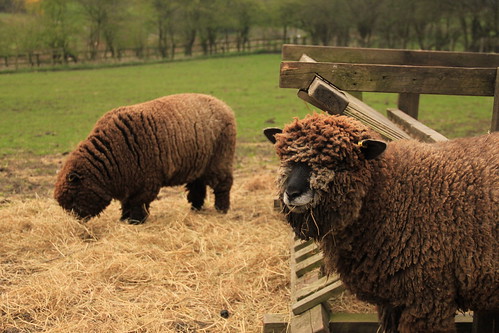
Proponents argue urban farming can reduce carbon emissions, but are growing crops in a city a baaaaa-d idea to start with? Photo by flickr user twenty_questions
A quick look at some of the things that make Urban Vertical Farming in your city work (or not):
Average distance ingredient in a meal in US is grown away from home: 1500 miles
Amount of energy global industrial food system accounts for in worldwide fossil fuel consumption: 21%
Number of farmer markets in US in 1993: 1755
Number of farmer markets in US in 2002: 3100
Percentage of food sales: 0.3%
Number of times more carbon dioxide released by transport of conventional produce versus regional/local produce: 5-17
Projected population by 2050: 9.5 billion
Additional land required to feed extra 2.7 billion people: Land mass of Brazil
Percentage increase in food production required by 2050: 70
Potential solution: Vertical farming
Numbers of acres of food a 30 story vertical farm can produce: 2400
Number of people a 19 story vertical farm could feed: 50,000
Number of acres of wheat in US: 53 million
Number of times more electricity needed to produce a year’s worth of US wheat via vertical farming: 8x total electricity generated in the US
For corn: 40x total electricity generated
Monetary worth of a farmer’s land per square foot: $1
Skyscraper: $200
Tons of carbon dioxide produced per US household due to food consumption: 8.9
Percentage of total carbon dioxide released due to food delivery: 4.5%
Number of days in jail for planting veggies in your front yard: 90

8 Comments
Hey there, this is a ton of great information. I’d love to reference this post, but curious as the source(s)?
If you have an opportunity try visiting TerraSphere Systems’ website, http://terraspheresystems.com/, they are currently in business with Vertical farms up and running in Canada and their website is very informative (Watch the “Two Seeds, Two Stories” video). Also visit another company I have been researching, Converted Organics http://convertedorganics.com/, they produce organic fertilizer by using food waste that is composted in a weeks time. Converted Organics and Terrashpere recently announced that they will be building a vertical farm in Rhode Island. I am not affiliate with Terrasphere, just thought you might want to take a look.
@ joe bertino: if you click on the stat on each line, it will take u to the source.
@ Jake: vertical farms in canada? i gotta see this.. do u know where they’ve set some up?
–> >>Additional land required to feed extra 2.7 billion people: Land mass of Brazil<<
To feed extra 2,7 billion people with meat OR ONLY wheat OR meat and wheat ? Or Burgers? Average american food or average chinese food ?
Judging from the quote below, I’d say churrasco:
“Together the world’s 6.8 billion people use land equal in size to South America to grow food and raise livestock—an astounding agricultural footprint. And demographers predict the planet will host 9.5 billion people by 2050. Because each of us requires a minimum of 1,500 calories a day, civilization will have to cultivate another Brazil’s worth of land—2.1 billion acres—if farming continues to be practiced as it is today.”
Source: http://www.scientificamerican.com/article.cfm?id=the-rise-of-vertical-farms
About food production have a look to:
http://www.youtube.com/watch?v=FC5vQpBRjCk
http://www.youtube.com/watch?v=jH72ssqdhXI
But its not only the food production. When the state builds highways, the money lacks to reduce number of students in school classes, the money lacks to bring the students a better education, and so on.
Who sows highways, who will harves car-traffic (and car-jams). We need more public transportation. And cable propelled transit is one of the possibilities.
Delete my second 2 comments, if you want. It’s better to write about traffic, but for what these wrong numbers about food production?
hrough the ages man has been in cultivation. The Early man lived on cultivating the land around him. Most people had huge lands under cultivation. As the years passed, different kinds of building came around. People started to build houses in one area and various kinds of businesses came into existence. In this process people started to cut down trees. Due to this fact we know in many countries the agricultural output has also decreased. For who people who still cultivate agriculture, the land for cultivation has significantly decreased. Not only this with the increase in population, people need more places to stay. .
My very own blog page
<'http://www.foodsupplementcenter.com/red-clover-tea/